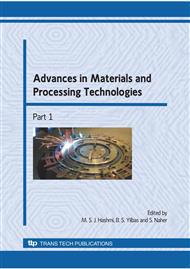[1]
Council of the European Communities. Council Directive 76/464/EEC of 4 May, (1976) on Pollution Caused by Certain Dangerous Substances Discharged into Aquatic Environment of the Community; Official Journal. 1976, 129, pp.23-29.
DOI: 10.1017/s0020782900034732
Google Scholar
[2]
United States Environmental Protection Agency. Water Related Fate of the 129 Priority Pollutants; Doc. 745-R-00-007; USEPA: Washington, DC. 1979, Vol. 1.
Google Scholar
[3]
M. Filela, M.; Belzile, N.; Chen, Y.W. Antimony in the environment: a review focused on natural waters I. Occurrence, Earth-Sci. Rev. 2002, 57, pp.125-176.
DOI: 10.1016/s0012-8252(01)00070-8
Google Scholar
[4]
Y.W. Chen, Y.W., Deng, T.L.; Filella, M.; Belzile, N., Distribution and early digenesis of antimony species in sediments and pore-waters of freshwater lakes, Environ. Sci. Technol. 2003, 37, pp.1163-1168.
DOI: 10.1021/es025931k
Google Scholar
[5]
Gebel, T. Arsenic and antimony: Comparative approach on mechanistic toxicology, Chem., Biol. Interact. 1997, 107, pp.131-144.
DOI: 10.1016/s0009-2797(97)00087-2
Google Scholar
[6]
WHO, Antimony in drinking water. Background document for development WHO Guidelines for drinking water quality, www. antimony in drinking water, (2003).
DOI: 10.1007/springerreference_30502
Google Scholar
[7]
Toxicological profile for antimony and compounds, US Department of Health & Human Services, ATSDR/TP-91/02, September (1992).
Google Scholar
[8]
Onishi, H, Antimony. In Handbook of Geochemistry; K.H. Wedeppohl (ed). Springer- Verlag: Berlin. 1978, Vol. II/4.
Google Scholar
[9]
Pourbaix, M. Atlas of electrochemical equilibrium in aqueous solution. New York: Oxford, Pergamon. 1996, p.644.
Google Scholar
[10]
Kang, M.; Kamei, T.; Magara, Y. Comparing polyaluminum chloride and chloride for antimony removal, Water Research. 200, 37, pp.4173-4179.
DOI: 10.1016/s0043-1354(03)00351-8
Google Scholar
[11]
Edwards, M. Chemistry of arsenic-removal during coagulation and Fe-Mn oxidation, J. Am. Water Works Assoc. 1994, 86, pp.64-78.
DOI: 10.1002/j.1551-8833.1994.tb06247.x
Google Scholar
[12]
Pawlak, Z., Rabiega, G., Scanlan, L. Cartwright, P. Speciation of arsenic in groundwater and technologies for removal of arsenic in drinking water in the Spiro Tunnel Bulkhead, Park City, Utah, USA, Ars Separatoria Acta 2003, 2, pp.71-83.
DOI: 10.4028/www.scientific.net/amr.83-86.553
Google Scholar
[13]
E. Wiberg, E.,. Holleman, A.F. Inorganic Chemistry, Elsevier, (2001).
Google Scholar
[14]
Kang, M., Kawasaki, M.; Tamada, S.; Kamei, T.: Magara, Y. Effect of pH on the removal of arsenic and antimony using reverse osmosis membrane, Desalination 2000, 11, pp.293-298.
DOI: 10.1016/s0011-9164(00)90027-4
Google Scholar
[15]
Stefansson, A. Iron (III) hydrolysis and solubility at 25 oC, Enviromn. Sci. Technol. 2007, 41, pp.6117-6123.
Google Scholar
[16]
Pawlak, Z.; Zak, S.; Zablocki, L. Removal of hazardous metals from groundwater by reveres osmosis, Polish J. Environ. Stud. 2006, 15, pp.579-583.
Google Scholar
[17]
Park City SWTP. http: /www. parkcity. org/citydepartments/water/projects/. (2008).
Google Scholar
[18]
Pawlak, Z.; Rauckyte, T.; Zak, S.; Praveen, P. Study of arsenic in mine ground-water commonly used for human consumption in Utah, Environ. Technol. 2008, 29, pp.217-224.
DOI: 10.1080/09593330802028956
Google Scholar
[19]
NSF Report No. 01/26/EPADW 395, March, Environmental Technology Verification Report, Removal of Arsenic in Drinking Water. Electronic copy available on EPA website: http: /www. epa. gov/etv or NSF website: http: /www. nsf. org/etv. (2001).
DOI: 10.13031/2013.6046
Google Scholar
[20]
NSF Report 01/23/EPADW 395, Environmental Technology, September 2001, Verification Report. Removal of Arsenic in Drinking Water. Electronic copy available on EPA website: http: /www. epa. gov/etv or NSF website: http: /www. nsf. org/etv. (2001).
DOI: 10.13031/2013.6046
Google Scholar
[21]
EPA Office of Ground Water and Drinking Water, EPA Methods is available from National Technical Information Services (NTIS).
Google Scholar
[22]
18th Edition of Standard Methods for the Examination of Water and Waste Water American Water Works Association. (1992).
Google Scholar
[23]
D. Clifford, D.; L. Ceber, L.; Chow, S. Arsenic (III)/arsenic (V) separation by chloride-form ion-exchange resins, Proceedings of the XI AWWA Water Quality Technology Conference (WQTC), December 1983, Norfolk, VA. 1984, pp.223-236.
Google Scholar
[24]
Edwards, S.; Patel, S.; McNill, L.; Chen, H.; Frey, M.; A.D. Eaton, A.D.; Antweiler, R.C.; Taylor, H.E. Considerations in As analysis and speciation, J. Am. Water Works Assoc. 1998, 90, pp.103-113.
DOI: 10.1002/j.1551-8833.1998.tb08402.x
Google Scholar
[25]
Ficklin, W.H. Separation of arsenic (III) and arsenic (V) in groundwaters by ion exchange Talanta. 1983, 30, pp.371-373.
DOI: 10.1016/0039-9140(83)80084-8
Google Scholar
[26]
Shokes, T.E.; Moller, G. Removal of dissolved heavy metals from acid using iron metal. Environ. Sci. Technol. 1999, 33, pp.282-287.
DOI: 10.1021/es980543x
Google Scholar
[27]
Stumm, W.; Morgan, J.J. Aquatic Chemistry: Chemical Equilibria and Rates in Natural Waters, third ed. John Wiley & Sons, Inc. New York, (1996).
Google Scholar
[28]
Leyva, A.D.; Marrero, J.; P. Smichowski, P.; Cicerone, D. Sorption of antimony onto hydroapatite, Environ Sci. Technol. 2001, 35, pp.3669-3675.
DOI: 10.1021/es0009929
Google Scholar
[29]
Dixit, S.; Hering, J.G. Comparison of arsenic (V) and arsenic (III) sorption onto iron oxide minerals: Implication for arsenic mobility, Environ. Sci. Technol. 2003, 37, pp.4182-4289.
DOI: 10.1021/es030309t
Google Scholar
[30]
Baes, C.F.; R.E. Mesmer, R.M. The Hydrolysis of Cations, Wiley, New York. (1976).
Google Scholar
[31]
A.K. Leuz, H. Monch and C.A. Johnson, Sorption of Sb (III) and Sb (V) to goethite: Influence on Sb(III) oxidation and mobilization, Environ. Sci. Technol. 2006, 40, pp.7277-7282.
DOI: 10.1021/es061284b
Google Scholar
[32]
Leuz, A.K.; Monch, H.; Johnson, C.A. Iron-mediated oxidation of antimony (III), by oxygen and hydrogen peroxide compared to arsenic (III) oxidation, Environ. Sci. Technol. 2006, 40, 25652571.
DOI: 10.1021/es052059h
Google Scholar
[33]
Batelle, Evaluation of treatment technologies for the removal of arsenic from drinking waters: iron removal. Prepared for EPA, February (2000).
Google Scholar
[34]
Ning, R.Y.; Arsenic removal by reverse osmosis. Desalination, 2002, 143, pp.237-241.
DOI: 10.1016/s0011-9164(02)00262-x
Google Scholar
[35]
Sledge, G.D. Proposed arsenic in drinking water rule regulatory impact analysis, EPA 815-R000-013, chapter 6, June (2000).
Google Scholar
[36]
NSF Report 01/25/EPAWD395, Environmental Technology Verification Report. Removal of arsenic in drinking water, Electronic copy is available on EPA website: http: /www. epa. gov/etv or NSF website: http: /www. nsf. org/etv. August (2001).
DOI: 10.13031/2013.6046
Google Scholar
[37]
NSF Report 01/20/EPADW395, Environmental Technology Verification Report. Removal of arsenic in drinking water, Electronic copy available on EPA website: http: /www. epa. govetv or NSF website: http: /www. nsf. org/etv. March (2001).
DOI: 10.13031/2013.6046
Google Scholar


